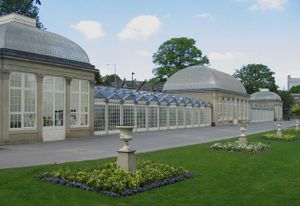
Sheffield Botanical Gardens
Encyclopedia

Botanical garden
A botanical garden The terms botanic and botanical, and garden or gardens are used more-or-less interchangeably, although the word botanic is generally reserved for the earlier, more traditional gardens. is a well-tended area displaying a wide range of plants labelled with their botanical names...
s situated off Ecclesall Road
Ecclesall Road
|thumb|200px|right|Ecclesall Road South, which runs through a large part of the Hallam Constituency, the second wealthiest in the UK.Ecclesall Road is a road in Sheffield that runs for about 3.5 miles south-west from Sheffield's city centre under the number A625...
in Sheffield
Sheffield
Sheffield is a city and metropolitan borough of South Yorkshire, England. Its name derives from the River Sheaf, which runs through the city. Historically a part of the West Riding of Yorkshire, and with some of its southern suburbs annexed from Derbyshire, the city has grown from its largely...
, England
England
England is a country that is part of the United Kingdom. It shares land borders with Scotland to the north and Wales to the west; the Irish Sea is to the north west, the Celtic Sea to the south west, with the North Sea to the east and the English Channel to the south separating it from continental...
, with 5,000 species
Species
In biology, a species is one of the basic units of biological classification and a taxonomic rank. A species is often defined as a group of organisms capable of interbreeding and producing fertile offspring. While in many cases this definition is adequate, more precise or differing measures are...
of plant
Plant
Plants are living organisms belonging to the kingdom Plantae. Precise definitions of the kingdom vary, but as the term is used here, plants include familiar organisms such as trees, flowers, herbs, bushes, grasses, vines, ferns, mosses, and green algae. The group is also called green plants or...
in 19 acres (77,000 m2) of land.
The gardens were designed by Robert Marnock
Robert Marnock
Robert Marnock was one of the outstanding horticulturalists and garden designers of the 19th century and was considered by his contemporaries to be the best exponent of the gardenesque school of landscape gardening....
and first opened in 1836. The most notable feature of the gardens are the Grade II* listed glass
Glass
Glass is an amorphous solid material. Glasses are typically brittle and optically transparent.The most familiar type of glass, used for centuries in windows and drinking vessels, is soda-lime glass, composed of about 75% silica plus Na2O, CaO, and several minor additives...
pavilion
Pavilion (structure)
In architecture a pavilion has two main meanings.-Free-standing structure:Pavilion may refer to a free-standing structure sited a short distance from a main residence, whose architecture makes it an object of pleasure. Large or small, there is usually a connection with relaxation and pleasure in...
s, restored and reopened in 2003. Other notable structures are the main gateway, the south entrance lodge and a bear pit
Bear pit
A bear pit was historically used to display bears, typically for entertainment and especially bear-baiting. The pit area was normally surrounded by a high fence, above which the spectators would look down on the bears....
.
The Sheffield Botanical and Horticultural Society was formed in 1833 and by 1834 had obtained £7,500 in funding. The money was raised selling shares, permitting the purchase of 18 acres (72,843.5 m²) of south-facing farmland from the estate of local snuff
Snuff
Snuff is a product made from ground or pulverised tobacco leaves. It is an example of smokeless tobacco. It originated in the Americas and was in common use in Europe by the 17th century...
manufacturer Joseph Wilson. 12,000 people visited the Gardens on their opening in the Summer of 1836. Sheffield's Town Trust
Sheffield Town Trust
The Sheffield Town Trust, formerly officially known as the Burgery of Sheffield, is a charitable trust operating in Sheffield, South Yorkshire, England.-Mediaeval period:...
assumed the management of the gardens in the closing years of the 19th. century, when they repaid the shareholders the nominal value of their £5 shares. The Trust abolished the existing entry charge and since that time entry to the Botanical Gardens has remained free. Though the Town Trust are still the owners, Sheffield Corporation
Corporation
A corporation is created under the laws of a state as a separate legal entity that has privileges and liabilities that are distinct from those of its members. There are many different forms of corporations, most of which are used to conduct business. Early corporations were established by charter...
signed a 99-year lease
Lease
A lease is a contractual arrangement calling for the lessee to pay the lessor for use of an asset. A rental agreement is a lease in which the asset is tangible property...
on 18 December 1951, thereby taking over management.
The gardens hold the national collection of the genus [Sarcococca], Weigela
Weigela
Weigela is a small genus of about 12 species of deciduous shrubs in the family Caprifoliaceae, growing to 1-5 m tall. All are natives of eastern Asia. The genus is named after the German scientist Christian Ehrenfried Weigel....
and the closely related Diervilla.

